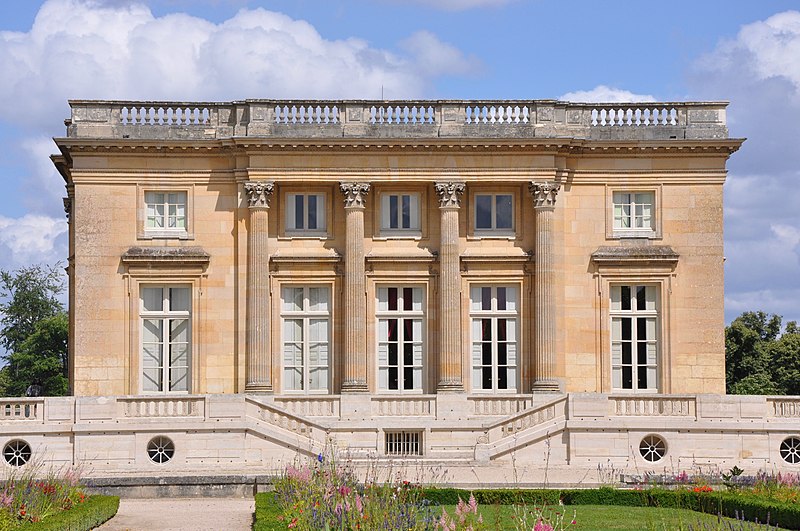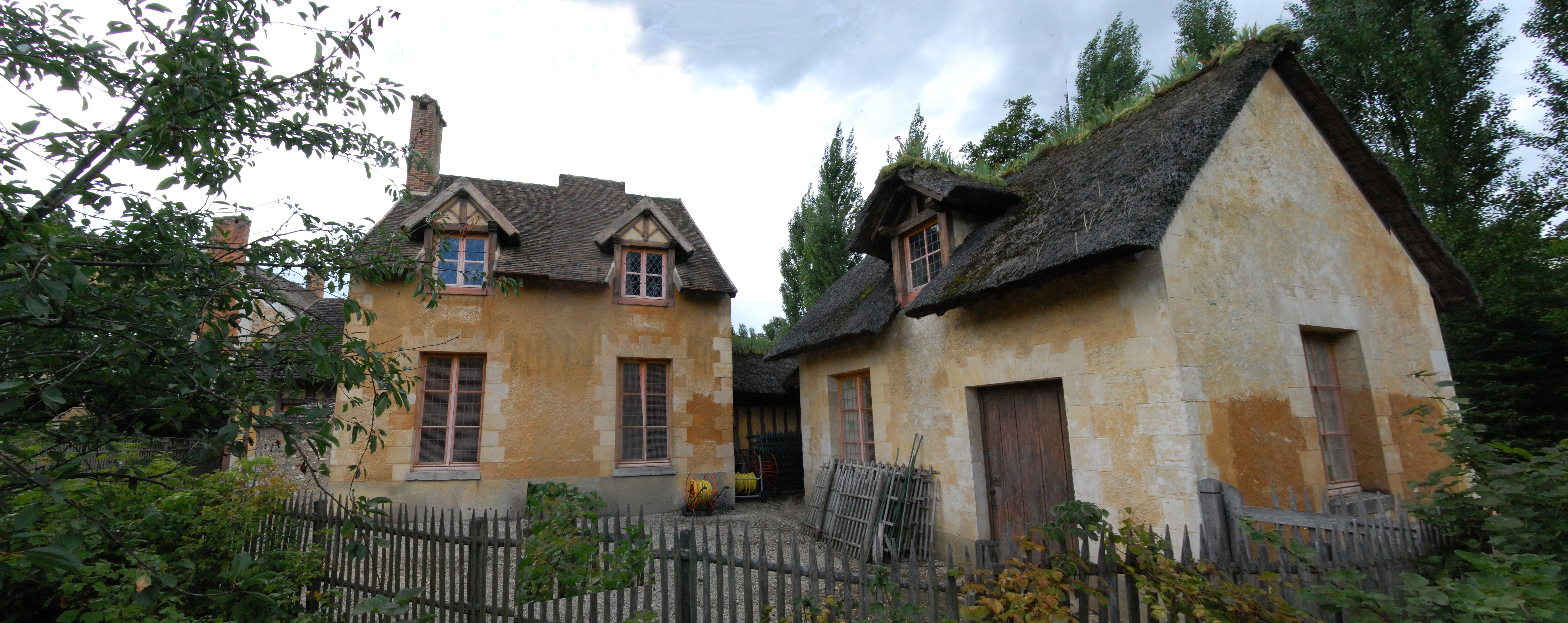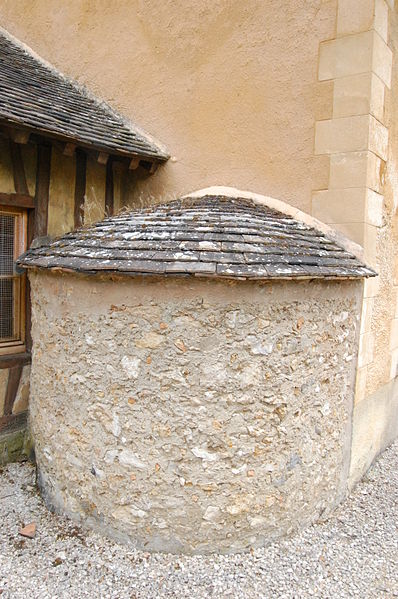The Hidden Kitchen of Versailles:
The Réchauffoir of the Hameau de la Reine
 |
| The Château of Versailles, ca. 1722, by Pierre-Denis Martin. |
Versailles is one of the most spectacular palaces in the world. As tourists will find, there are surprisingly few servants' rooms included on the public route. Designed to be well hidden, many of the old service areas are currently occupied by offices, workrooms, restoration facilities, and visitors' services.
Only one kitchen is included on the public route: the réchauffoir of the Petit Trianon. The Petit Trianon is a small palace located within the park of Versailles, north of the main château. It was built by Louis XV for his mistress, Madame de Pompadour, but was completed in 1768 after her death.
A réchauffoir is not a kitchen, properly speaking. They were used to re-heat food that had already been prepared in the Petit Trianon's main kitchen, with relatively minor prep and cookery carried out within the réchauffoir itself. The Trianon's main kitchen was located directly west of the entry gate, and is currently occupied by "Angelina Tea Salon".
 |
| Plan of the Petit Trianon and park in 1774. "C"marks the kitchens. |
| |
This arrangement - separating the main kitchen from the house and relying on a small réchauffoir for final service - allowed for reduced cooking smells in the state rooms, less noise and commotion in the main house, and facilitated delivery of orders to an area that was hidden and self-contained.
 |
| Petit Trianon. |
 |
| Réchauffoir inside the Petit Trianon. |
There is, however,
another réchauffoir at the Petit Trianon that is not open to the public: the
réchauffoir of the Hameau de la Reine. Constructed as a model pleasure village
exclusively for the use Marie Antoinette and her closest friends, Louis XVI added
the Hameau to the existing park of the Petit Trianon in 1783. The buildings,
farms, ponds, and gardens were designed to look idyllically rustic.
"Villagers" were hired to live in some of the houses of the village
and tend to the animals and grounds. The
Hameau was not a place of agriculture; instead, the inhabitants' primary
occupation was that of preserving an idealized rural ethos that Marie
Antoinette could enter and exit at will.
 |
| A view of the main area of the Hameau de la Reine. |
 |
| Another view of the same. |
For those who haven't been or didn't have time to see the Hameau (it is a far trek from the main château), I will include a picture of the dairy. This gives a sense of how the interiors of the buildings were often put to unexpected uses. The dairy is inside a small house connected to the Marlborough Tower, as seen here:
 |
| "Malborough Tower" with the dairy (laiterie) to the right. |
 |
| Approach to the dairy. |
 |
| Interior of the dairy |
Since the high ladies at court never cooked for themselves, foodservice areas had to be incorporated into the design of the Hameau without disrupting the aesthetic of the village. Richard Mique, the Hameau's designer, decided to rely on the main kitchens of the Petit Trianon (near the main gate), and provide a small réchauffoir to service the village when Marie Antoinette was present.
 |
| Mique's réchauffoir in the Hameau. |
|
 |
| Another view of the same. |
 |
| Group. |
What people don't usually get to see is the interior of the réchauffoir. This one is not as large as the réchauffoir in the Petit Trianon, but we can see that it is certainly a substantial building. Like the dairy, it was designed to resemble a wattle-and-daub cottage from the exterior, though the core of the building was of cut stone.
 |
| Entering the cooking area of the réchauffoir |
 |
| The hearth and baking oven. |
A very fine baking oven and hearth are built into an interior wall of the réchauffoir, sharing a single chimney by means of a joined hood over the oven door. Under the oven a deep, arched kindling store allows for logs to be placed well back into the niche. As we can see in a picture further below, the body of the baking oven sits outside the réchauffoir and does not have its own chimney. The fume hood protrudes from the wall just enough to catch vapour and heat when the oven door is opened, venting immediately through the main flue of the hearth. Iron spit hooks are built into the masonry of the hearth and were meant to hold spits when not in use. The workmanship on the hearth is excellent; fire bricks cased in cut stone line the walls of the hearth while the fire brick on the hearth's floor is exposed.
 |
| The stoves. |
Along the opposite wall sits an eighteenth-century range. This style of range would fall out of favour with the rise of cast iron ranges in the nineteenth century. This one, however, escaped "enclosure". There were a number of ways to use these stoves. When moderate or high heat was required, fuel could be placed directly into the receptacle and a pan or pot placed atop. An iron grate was built into the bottom of the receptacle allowing ash to pass through into a compartment near the floor. When less intense heat was needed, a grate could be placed over the depression, coals placed atop the grate to allow the ash to fall into the receptacle, and a trivet placed over the coals to act as a stand for a pan.
 |
| Exterior of the réchauffoir with oven protruding. |
The réchauffoir of
the Hameau offers a snapshot of the cookery methods that were required for a
comparatively small-scale, informal eighteenth-century royal catering
operation: roasting, baking, frying, boiling. In essence, every function that a
kitchen would normally have to serve without the massive larders, butcheries,
and prep spaces possessed by the larger kitchens at Versailles. Smaller,
however, doesn't mean easier. One assumes that strict schedules would have been
enforced on servants to stock the réchauffoir from the main kitchen before the
Hameau was in use by the queen; it is unlikely scullions were allowed to carry
old pots and baskets of bread through the park once the queen arrived. Planning,
packing, and transporting just enough of the right supplies to the réchauffoir speaks to a well-oiled machinery of royal
kitchen officers and servants who had
considerable competence in adapting the demands of their occupation to the
circumstances as they presented themselves at Versailles.
The buildings at the Hameau are closed to the public though visitors can walk around the grounds. The contents of the buildings were stripped during the Revolution but most buildings escaped destruction. After the Revolution, the Hameau was largely abandoned with some efforts made both to demolish and preserve it in the years since. A major restoration program was carried out in the 1990's, with various sections of the park reopening to the public throughout the late 1990's and early 2000's.
Although the
réchauffoir of the Hameau is small by comparison to other royal kitchens of
Europe, it speaks to the remarkable diversity of the catering operations at the Petit Trianon. It has undergone very little change since
the Revolution, so it is one of the few places on the estate from which we can
get a partial sense of how the French royal cooks managed and divided their
work during the twilight of the Ancien Régime.
(Photo Credits: Image bank of the "Wikimedia Partnership with the Château de Versailles, 2011" facilitated by "Wikipedian in residence", Benoît Evellin. 1774 map of the Trianon added to Wikimedia by user Starus from the Centre de recherche du château de Versailles. Also, personal photos.)
By: Ryan Whibbs
















No comments:
Post a Comment
Note: only a member of this blog may post a comment.